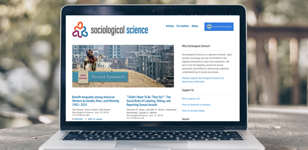Menu
Scholastica customer stories
Read case studies about how journals use Scholastica software and services to work more efficiently and publish modern articles online.

Journals are using Scholastica to manage their entire publishing process — from peer review to production to website hosting and design

Bond University migrates to Scholastica's peer review system and OA publishing platform to make its journals fully digital
Bond University's Scholarly Publications Manager Antoinette Cass and Publications Officer Doreen Taylor discuss why they migrated the university's journals to Scholastica's peer review system and OA publishing platform to make them more digitally driven and that experience.
Read more
How Scholastica helped Spartan Medical Research Journal speed up peer review and get indexed in PMC
Since making the switch to Scholastica, the Spartan Medical Research Journal has found that its peer review process is smoother for editors and authors, its digital reading experience is more engaging, and the journal has the XML it needs to pursue new indexing opportunities.
Read more
Why Survey Practice chose Scholastica to streamline its peer review and production processes and publish faster
Ashley Amaya, former editor-in-chief of the American Association for Public Opinion Research's journal, Survey Practice, discusses how migrating to Scholastica's peer review system, production service, and OA publishing platform helped them centralize workflows and publish faster.
Read moreCustomers have great things to say about Scholastica!

As a not-for-profit, we found Scholastica to be affordable for us and the easiest alternative for the authors and editors to use. We have been able to customize our material in a way we didn't think possible before, and the technical staff have been very helpful in getting us up and running. Scholastica has become an integral part of our long-term growth plan.
Timothy B. Michael
Publisher
See how journals are streamlining their peer review processes with Scholastica

Reflections on a decade using Scholastica at GEP, an MIT Press journal
Susan Altman, Managing Editor of MIT Press' Global Environmental Politics journal, reflects on GEP's transition to Scholastica's peer review system, the editorial team's experience working with Scholastica over the past decade, and the journal's evolution up to this point.
Read more
On a mission to increase journal publishing efficiency at Penn Press
In this interview, the University of Pennsylvania Press' Director of Journals, Jocelyn Dawson, and Operations Manager, Paul Chase, share how they're working to develop their journal portfolio and support DEIA initiatives at Penn Press and beyond.
Read more
Streamlining Journal Operations at The University of Illinois Press
In recent years, the University of Illinois Press team has focused on embracing opportunities to streamline operations to keep scaling their publishing program. Scholastica caught up with Journals Manager Clydette Wantland to learn more about UIP's approach to portfolio development and goals for 2024.
Read more
How Sociological Science makes faster manuscript decisions using Scholastica
Jesper Sørensen, editor-in-chief of Sociological Science, discusses how Scholastica's centralized peer review software has enabled them to set up a streamlined editorial workflow leveraging their large team to make publication decisions in 30 days or less.
Read more
Doing More With Less: ITE Journal Uses Scholastica for More Efficient Peer Review
Since moving to Scholastica's peer review system, Managing Editor of ITE Journal Marianne Saglam says their editorial team has been less stressed about journal management because the software is helping them save time and ensure manuscripts stay organized.
Read more
Efficient peer review and editorial control: Why WBCRJ chose Scholastica
Founding editor of the Wine Business Case Research Journal, Armand Gilinsky, discusses how he launched the open access journal and how Scholastica has helped them set up a streamlined peer review process with impressive manuscript turnaround times.
Read moreJournals are producing professional articles and creating modern websites with Scholastica

Providing Students Hands-On Journal Publishing Experience: Curiosity Launches Using Scholastica
Assistant Director of Undergraduate Research at Utah Tech University Olga Pilkington discusses how she used Scholastica to launch the university's first student-run OA journal, Curiosity: Interdisciplinary Journal of Research and Innovation.
Read more
How the Journal of Health Economics & Outcomes Research became Plan S compliant using Scholastica
The managing editors of the Journal of Health Economics & Outcomes Research share how transitioning to Scholastica's peer review system, production service, and OA publishing platform enabled them to meet the Plan S implementation guidelines.
Read more
How the journal of the European Foundation for Clinical Nanomedicine launched using Scholastica
Lajos Balogh, editor-in-chief of Precision Nanomedicine, discusses how the official journal of the European Foundation for Clinical Nanomedicine launched quickly and without technical hassles using Scholastica's peer review system and OA publishing platform.
Read moreLaw reviews use Scholastica to improve article selection and make their online publications more discoverable and engaging

Stanford Law Review Joins Scholastica: Improving review process with better technology
Stanford Law Review's Senior Articles Editor Karen Ding discusses why they chose to move to Scholastica's submission and article selection system to improve their editorial workflows and author experience.
Read more
Houston Law Review Uses Scholastica publishing tools for improved reading experience and discoverability
Houston Law Review's former editor in chief shares how they are using Scholastica publishing tools and services to make their content more discoverable online and empower readers to explore the law review from all digital devices.
Read more
